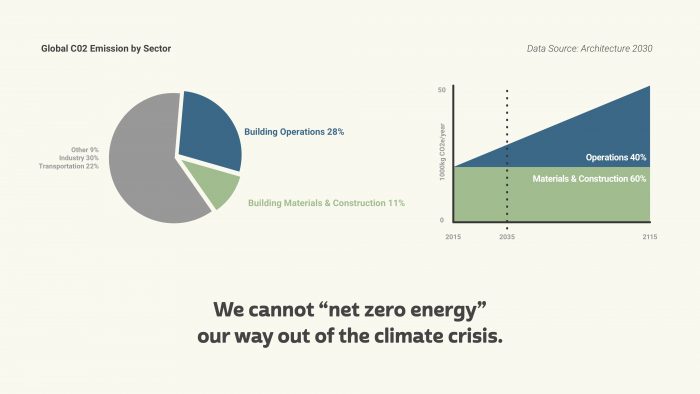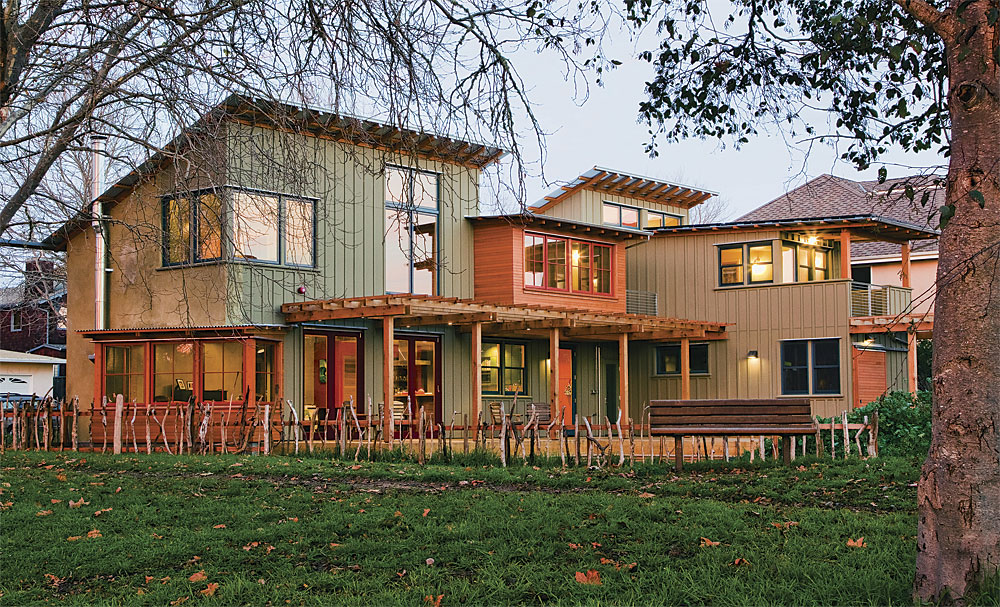
Phil and Chris, hosts of the Green Architects’ Lounge Podcast, define and discuss embodied carbon in buildings, and make an impassioned case for understanding why this is absolutely the most urgent issue we face in the design and construction industry today—even ahead of zero-energy building—as we work together to combat a fast-approaching climate crisis.
Listen to the podcast
Embodied carbon is carbon that is emitted in the production of materials, and the building industry is responsible for 40% of global annual emissions. Buildings are the problem and the solution, and understanding the immediate impacts of embodied carbon is absolutely vital.
Phil and Chris define the critical difference between embodied and operational carbon, and explain why net-zero-energy buildings simply aren’t enough at this moment in time. They take a pass at understanding the numbers behind the issues. They also spend the second half of the podcast talking about the materials that we either must, or absolutely should not specify. Wood is good, steel and concrete are bad, but anyone in the industry knows that this doesn’t leave us with a simple puzzle to solve.
The Cocktail: The Bennett Cocktail
2 oz. Gin
¾ oz. Fresh lime juice
¾ oz. Simple syrup
2 dashes Angostura bitters
Directions: Shake all ingredients with ice to chill, then strain into a chilled glass. Garnish with a lime wheel.
The Highlights
- What is embodied carbon? Carbon that is emitted in the production of materials.
- 40% of global annual carbon emissions are caused by building industry.
- We need to understand eCO2e (embodied carbon emissions) vs. oCO2e (operational carbon emissions).
- What are the differences between embodied (upfront) vs. operational carbon? (11% embodied + 28% operational = 39% total)?
- We don’t have time to mess around. New zero-energy-buildings are simply not good enough to save us in time. Energy is not a proxy for carbon.
- Buildings are the problem and the solution. It’s best not to build at all, but if you must—and we must—embodied carbon emissions become critical.
How is our tribe doing already?
- For residential construction, we are doing pretty well, and it’s been a good testing ground. The nerds need to distill the data into actionable rules of thumb so the non-nerds can act.
- Commercial is the big nut to crack: 33% of embodied carbon is in the structure.
- We can’t get to net zero-carbon with a dirty grid.
- Transport of workers to the job site is the biggest source of emissions.
- Impact of the work we do is more important that personal changes we make.
- Sometimes it actually can be better to tear down and build a smaller, high performance building.
- Impacts of the construction process are 20-25% of the total.
Understanding the numbers
- Calculations now are right enough, we need action more than precision.
- Use only very round numbers—1,2,5,10,20,50,100—so they are retained.
- EPDs are the MPGs for buildings.
- How can a number be negative? Regenerative building can actually fix the environment.
Top five materials
- FSC-certified wood (all wood is not the same)
- Natural building materials (straw/hemp/wool)
- Cellulose insulation
- Cross-laminated timbers
- Wood fiberboard insulation
Bottom five materials
- Aluminum
- Concrete
- Steel
- Refrigerants
- Spray foam
Song of the episode
747 by Bill Callahan
Links
Carbon Smart Materials Palette
Carbon Cure
Carbon Leadership Forum
The New Carbon Architecture by Bruce King
Images courtesy of Chris Magwood, Endeavour Centre; Jacob Racusin, New Frameworks; Ace McArleton, New Frameworks.
The Green Architects’ Lounge hosts are Chris Briley and Philip Kaplan. Chris is a principal at BRIBURN architecture for life. Phil is a principal at Kaplan Thompson Architects. Never miss an episode and take the podcast with you! Subscribe to the Green Architects’ Lounge on iTunes or from wherever you download your podcasts. The show’s Theme Music is Zelda’s Theme by Perez Prado.
Special thanks to our sponsor Pinnacle Window Solutions!
Weekly Newsletter
Get building science and energy efficiency advice, plus special offers, in your inbox.















15 Comments
I didn't listen to the podcast, but did you consider the fact that aluminum and steel can be recycled when putting them in the bottom 5?
Or what about the fact that treated cellulose insulation can't be composted (can it be recycled?), and realistically most natural building materials will probably end up in a landfill if a building is taken down and if we don't change what we do with waste?
Does it even make sense to think about the end of life for these materials when there's no clear lifespan for a building? A structure built today might be standing for the next 30 years or up to a few hundred years.
“[Deleted]”
Is an eight inch thick concrete foundation overkill for a one story house?
Stephen,
I haven't looked at it recently, but our code used to allow 6" walls for one storey houses. There is no practical reason it couldn't be used. If more strength was needed, add more rebar. Aren't many ICF's 6"?
Keep in mind that in termite prone areas the code requires that at least 6(?) inches of slab remain above grade.
If transport of workers is the biggest problem then EVs are the obvious solution
Renewably powered.
>"If transport of workers is the biggest problem..."
The worker & material transport is really the bare tip of the embodied carbon iceberg of most new houses. (Did you listen to the podcast?)
Concrete is perhaps the biggest hard nut to crack, with limited alternatives widely commercially available.
Limiting the use of foam insulation is comparatively easy, as is limiting the use of steel & aluminum.
>"Or what about the fact that treated cellulose insulation can't be composted (can it be recycled?), and realistically most natural building materials will probably end up in a landfill if a building is taken down and if we don't change what we do with waste."
Un-composted cellulose is still sequestered carbon, as is landfilled wood. Assuming a lifecycle of 50-100 years I would expect deconstruction and re-use of structural wood would be more common than landfilling it at the end of service life in the new era. The carbon emissions of materials matter RIGHT NOW, for limiting the rise in global temperature over then next 50-100 years, far more than consideration of the residual value and disposal/reuse methods of the materials AFTER then next 50-100 years.
>"Does it even make sense to think about the end of life for these materials when there's no clear lifespan for a building?"
Yes- particularly so when considering the impact of refrigerant releases from foam insulation at end of life, barring cost effective disposal methods to prevent those releases.
Dana, there are widely available materials that can replace up to 50% of the Portland cement in concrete, when you have to use concrete. Pozzolan admixtures, including fly ash, don't affect the strength and can make it easier to place concrete. Every concrete batch plant has many standard mixes, including ones with pozzolan admixes. You just need to spec "standard mix with 30-50% pozzolan admix" and your other requirements and let the plant pick a recipe that uses the materials they have on hand. This approach won't solve everything, but with about 8% of total greenhouse emissions due to the manufacture of Portland cement, reducing the cement content by any fraction is a step in the right direction.
> Energy is not a proxy for carbon.
Lots of very important points. Hopefully all the misguided efforts being applied to net zero energy buildings can be redirected to holistic carbon reduction.
I listened to this episode and the Living Building Challenge episode. Are there any mini split manufacturers that have released materials lists and embodied carbon data, or something similar?
"the building industry is responsible for 40% of global annual emissions"
Can I get a source on that statement? The EPA seems to disagree.
https://www.epa.gov/ghgemissions/sources-greenhouse-gas-emissions
Calum, the EPA figures are for the US only, and "buildings" don't include the energy for heating or electricity.
This is the source I've used for global emissions (their total for buildings is 39%, not 40%): https://worldgbc.org/news-media/2018-global-status-report-towards-zero-emission-efficient-and-resilient-buildings-and
They cite these two sources:
https://www.iea.org/statistics/
https://www.iea.org/topics/energyefficiency/buildings/
Finally had a chance to listen to this podcast. Another great learning experience! Massive thanks to Chris and Phil for their work.
I have been a bit suspicious of wood as a carbon sink. However the case for FSC certified wood is compelling. I happened to look for the stamp while at the big box store the other day. Didn't see FSC bit did see a stamp for "sustainably" produced lumber. Not sure if this is mere green-washing or a meaningful qualification.
hey,
in which unit is the table where the co2 Emission in 4 different bars is shown? and what mean the shortcuts "MF" "HP" "CC" and "SF"?
Is there a reference list for the embodied carbon in each of your cocktails? :)
Log in or create an account to post a comment.
Sign up Log in